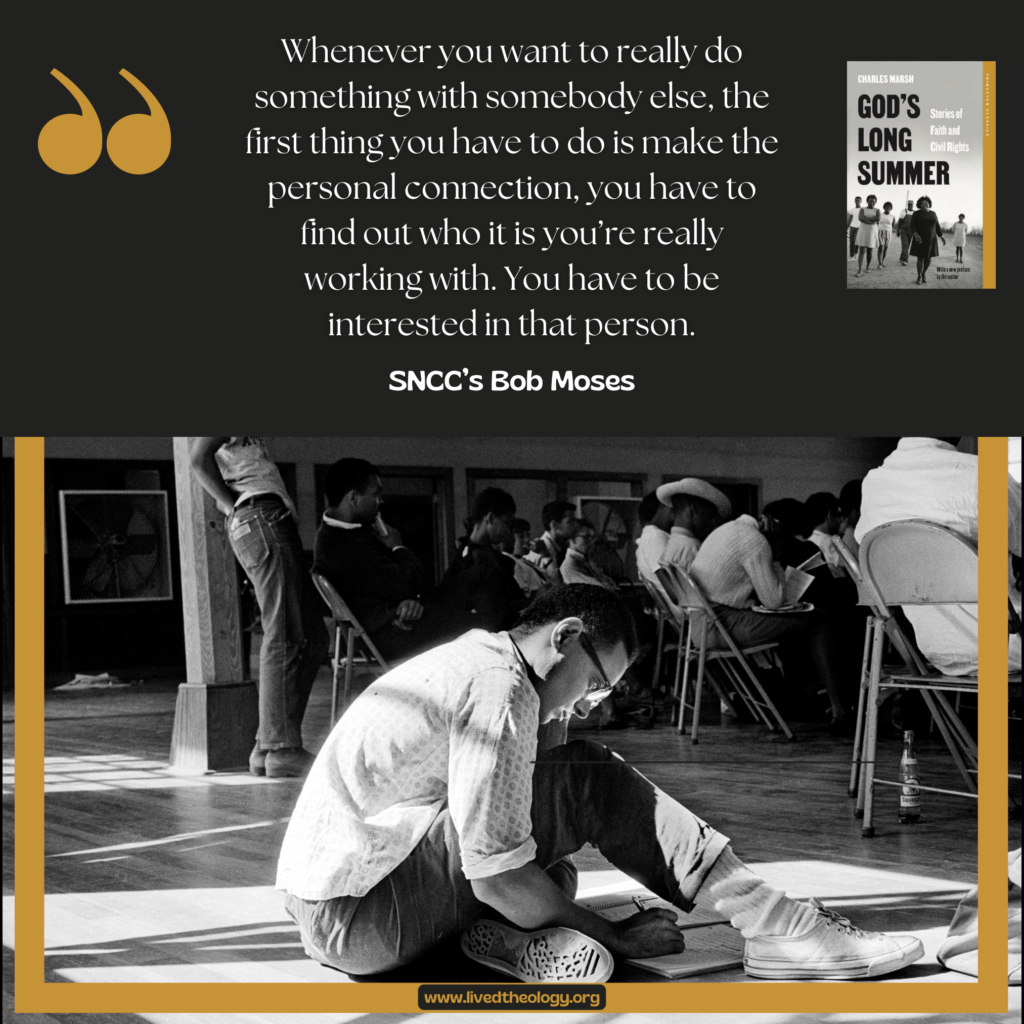August 14, 2024
Susan Glisson on SNCC’s Bob Moses:
“Robert P, known as Bob Moses, resides in Cambridge, Massachusetts, with his wife Janet Moses, a pediatrician. They have four children. Mr. Moses was born and raised in Harlem, New York, and received his BA from Hamilton College in 1956. In 1957, he received a Masters’ Degree in Philosophy from Harvard University and he taught middle school mathematics at the Horace Mann School in New York City from 1958-1961. I recall a phrase of when you saw the students in the first sit-in movements in 1960 in Greensboro, you said they looked how you felt and that feeling impelled you to come south, where you met Ella Baker, and she sent you to Mississippi. During his time there, Mr. Moses was a pivotal organizer in the Civil Rights movement as the field secretary for the Student Nonviolent Coordinating Committee, known as SNCC, and he was the director of SNCC’s Mississippi Project. He was widely credited as the architect of Freedom Summer in 1964, the effort to bring thousands of students into the state to register black voters, a driving force in the creation of the Mississippi Freedom Democratic Party, the result of the creation of a parallel institution in that effort. And from 1969-1976, he worked for the Ministry of Education in Tanzania in East Africa, where he was a teacher and chairperson for the math department in a school there.
“He returned to the United States in 1976 to pursue doctoral studies at Harvard. He’s been a MacArthur fellow and received numerous awards, but I think the most exciting thing that I can tell you about right now is that he helped to create the Algebra Project, which is a project that uses experiential learning. It draws from the work of Dewey, and a five step curricular process that Bob Moses helped innovate to help middle school students make the conceptual shift from arithmetic to algebra and to be prepared to take algebra in the eighth grade and thus a college preparatory math sequence in high school. I know you talk about math literacy and science literacy being the new civil rights issue for today. He is in Lanier High School in Jackson, Mississippi, four days a week, where he teaches the Algebra Project. It is my great honor to introduce the two of you.”
Dr. Glisson’s remarks were taken from the 2003 Conference on Lived Theology and Civil Courage. Video of the session, “Civil Rights as Theological Drama,” is posted below.
Charles Marsh on Victoria Gray Adams:
Victoria Gray Adams was a Black middle-class business woman who took her first step into the movement life during a church service in her home town of Hattiesburg, Mississippi. She would become a highly effective field secretary for the Student Nonviolent Coordinating Committee and help to create the Mississippi Freedom Democratic Party. After the movement years Ms. Adams settled in Petersburg, Virginia, with her husband and family. She served as the Wesleyan chaplain at Virginia State University.
In her visits between 2000 and 2006 with students at the UVA Project on Lived Theology, Ms. Adams spoke of the civil rights movement as “a journey toward the establishment of the kingdom of God,” as the “enfleshened church”. “We were seed people,” she said. “No matter how bleak the terrain looked out there, we were planted for a rich harvest. I don’t care whether you call yourself a Christian, Jew or Muslim. We didn’t have much of anything really except the church, and as we put our faith in these, they were burned down. But the church was there for us; the church as the representation of the spirit of love—of God. We were a seed people and a spirit-people; I don’t care whether you call yourself a Christian, Jew or Muslim. What happened back there in the 1960’s with ordinary people could not have happened without an understanding of ourselves as spirit-people.”
The year before she died, Mrs. Adams visited one of my undergraduate seminars at the University of Virginia. We were meeting in my home that afternoon. It was a cold winter day, and we gathered our chairs around the fireplace, listening to this riveting storyteller and civil rights saint. Mrs. Adams had a gift for invoking the spirit of the movement in a way that was palpable, and soon we were all singing freedom songs and spirituals. In what proved to be our last conversation, Victoria Gray Adams was asked by a student, “What is the mission of the Civil Rights movement today” “It is learning to speak the language of peace,” Mrs. Adams replied.

